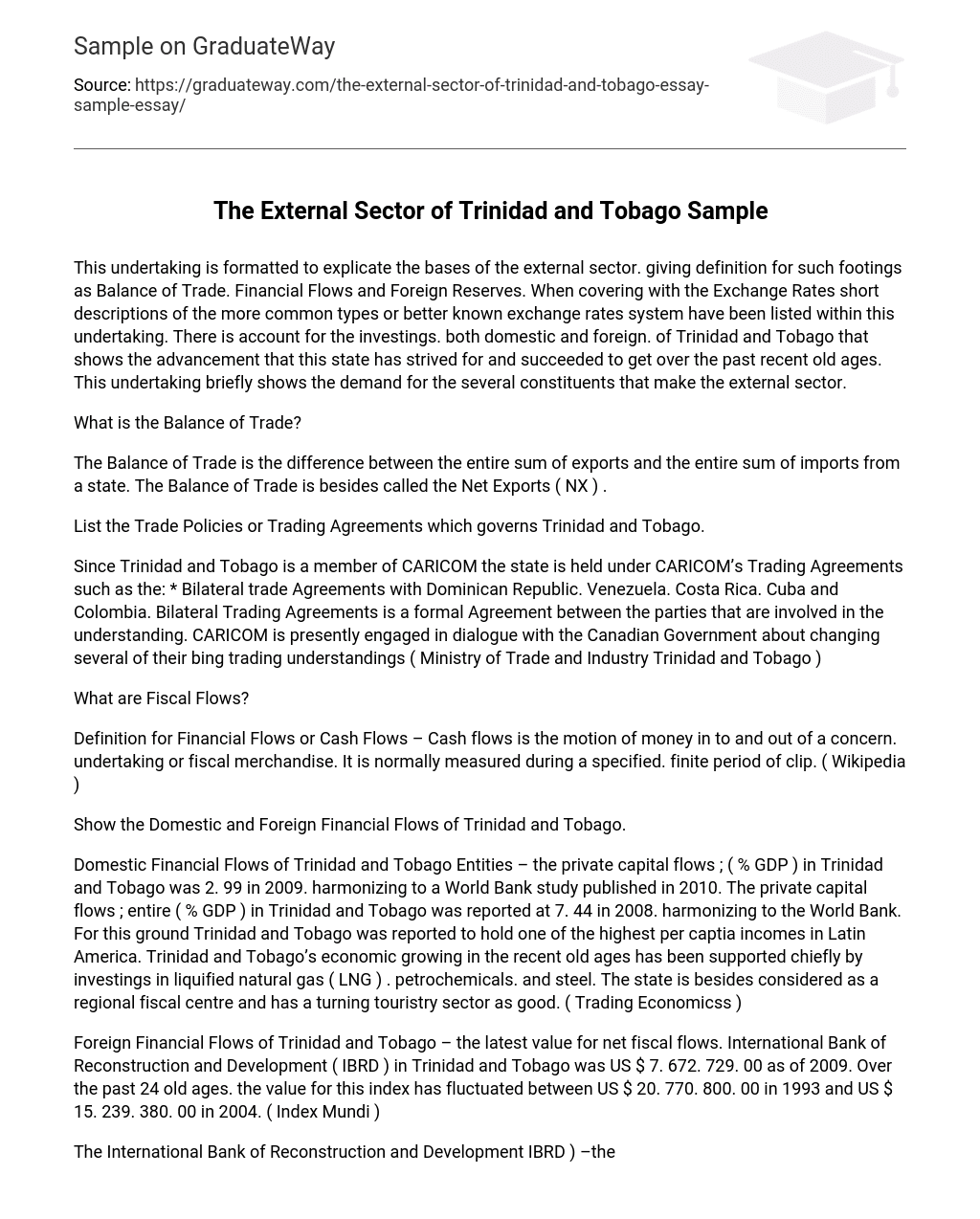This project is formatted to explain the basics of the external sector, giving definitions for such terms as Balance of Trade, Financial Flows, and Foreign Reserves. When dealing with the Exchange Rates, short descriptions of the more common types or better-known exchange rate systems have been listed within this project.
There is an account for the investments, both domestic and foreign, of Trinidad and Tobago that shows the progress that this state has strived for and succeeded to achieve over the past few years. This project briefly shows the demand for the several components that make up the external sector.
What is the Balance of Trade?
The Balance of Trade is the difference between the total amount of exports and the total amount of imports from a country. The Balance of Trade is also called Net Exports (NX).
List the Trade Policies or Trading Agreements that govern Trinidad and Tobago.
Since Trinidad and Tobago is a member of CARICOM, the country is held under CARICOM’s Trading Agreements such as the Bilateral Trade Agreements with the Dominican Republic, Venezuela, Costa Rica, Cuba, and Colombia.
Bilateral Trading Agreements are formal agreements between the parties involved in the understanding. CARICOM is presently engaged in dialogue with the Canadian Government about changing several of their existing trading agreements (Ministry of Trade and Industry Trinidad and Tobago).
What are Financial Flows?
The definition of Financial Flows or Cash Flows – Cash flows are the movement of money into and out of a business, project, or financial product. It is usually measured during a specified, finite period of time. (Wikipedia)
Show the Domestic and Foreign Financial Flows of Trinidad and Tobago.
Domestic Financial Flows of Trinidad and Tobago Entities – the private capital flows; (% GDP) in Trinidad and Tobago was 2.99 in 2009, according to a World Bank study published in 2010. The private capital flows; total (% GDP) in Trinidad and Tobago was reported at 7.44 in 2008, according to the World Bank.
For this reason, Trinidad and Tobago was reported to have one of the highest per capita incomes in Latin America. Trinidad and Tobago’s economic growth in recent years has been supported mainly by investments in liquefied natural gas (LNG), petrochemicals, and steel. The country is also considered a regional financial center and has a growing tourism sector as well. (Trading Economics)
Foreign Financial Flows of Trinidad and Tobago: The latest value for net fiscal flows of the International Bank of Reconstruction and Development (IBRD) in Trinidad and Tobago was US $7,672,729.00 as of 2009. Over the past 24 years, the value for this index has fluctuated between US $20,770,800.00 in 1993 and US $15,239,380.00 in 2004 (Index Mundi).
The International Bank of Reconstruction and Development (IBRD): The IBRD works with middle-income and responsible poorer states, offering loans, guarantees, risk management products, and analytical and consultative services (World Bank).
What are Foreign Reserves?
Foreign exchange reserves (also called forex reserves or FX reserves) – in a strict sense, are only the foreign currency deposits and bonds held by central banks and monetary authorities. However, the term in popular use usually includes foreign exchange and gold, special drawing rights (SDR), and International Monetary Fund (IMF) reserve positions. This broader figure is more readily available but is more accurately termed official international reserves or international reserves.
What is the purpose of the Foreign Exchange?
The purpose of the Foreign Exchange – in a flexible exchange rate system, official international reserve assets allow a central bank to buy the domestic currency, which is considered a liability for the central bank (since it prints the money of fiat currency as IOUs). This action can stabilize the value of the domestic currency. Central banks throughout the world have sometimes cooperated in buying and selling official international reserves in an effort to influence the exchange rates (Wikipedia).
Currency Evaluation
Floating Exchange Rates – in this system, the currency exchange rates are determined by the available supply of the currency and also the demand by other states for the currency. There is no intervention by the government in this system.
Currency Valuation Continued
Fixed Exchange Rates – the value of the currency is fixed according to an anchor currency. In this system, the exchange rates are not permitted to fluctuate. Buying Power Parity (PPP) – the PPP is the relationship between the exchange rates and the price levels in different countries. This is done when two countries’ currencies equate their buying power, and therefore the exchange rates adjust in correspondence to inflation (Rodriguez, 2012).
International Investment Position of Trinidad and Tobago
The International Investment Position (IIP) – the IIP is the balance sheet of the stock of external financial assets and liabilities. The financial items that comprise the position consist of claims on non-residents, liabilities to non-residents, monetary gold, and special drawing rights (SDR). In relation to the balance sheet (as delineated in the SNA) of an economy, the net international investment position, combined with an economy’s stock of non-financial assets, comprises the net worth of the economy.
The position at the end of the specific period reflects financial transactions that occurred during the period. In addition to these transactions, there could be valuation changes and other adjustments, all of which affect the level of assets and/or liabilities (Central Bank of Trinidad and Tobago).
Bibliography
- Central Bank of Trinidad and Tobago. (n.d.). Retrieved from the World Wide Web: central-bank.org.
- Index Mundi. (n.d.). Retrieved from the World Wide Web: indexmundi.com.
- Ministry of Trade and Industry Trinidad and Tobago. (n.d.). Retrieved from the World Wide Web: tradeind.gov.tt.
- Rodriguez, G. E. (2012, January – April). Macroeconomics 125 Notes. Trinidad.
- Trading Economics. (n.d.). Retrieved from the World Wide Web: tradingeconomics.com.
- Wikipedia. (n.d.). Retrieved from the World Wide Web: en.wikipedia.org.
- World Bank. (n.d.). Retrieved from the World Wide Web: worldbank.org.





